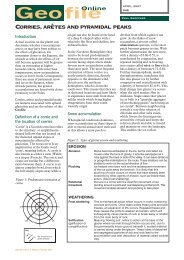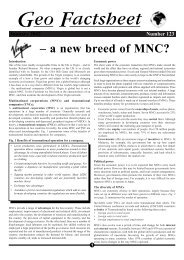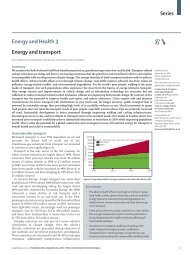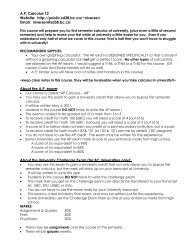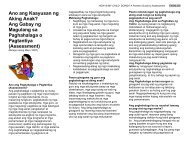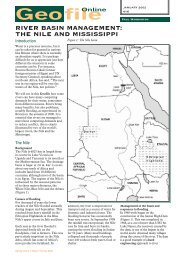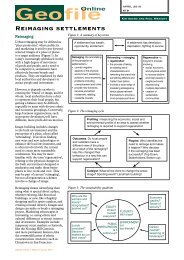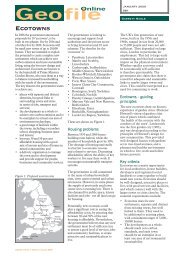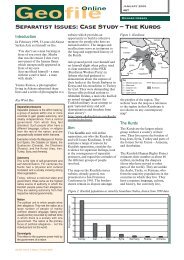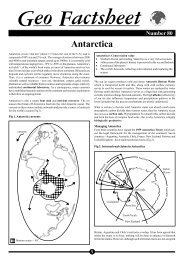25 Energy flow- Rainforests.pdf - Richmond School District No. 38
25 Energy flow- Rainforests.pdf - Richmond School District No. 38
25 Energy flow- Rainforests.pdf - Richmond School District No. 38
Create successful ePaper yourself
Turn your PDF publications into a flip-book with our unique Google optimized e-Paper software.
<strong>Energy</strong> Flow and Nutrient Recycling in Tropical <strong>Rainforests</strong><br />
Geo Factsheet<br />
Fig 5. The distribution of inorganic nutrients above and below ground in three TRF areas<br />
100<br />
Brazil (473 t/ha)<br />
(Lowland rain forest)<br />
N P<br />
140<br />
K Ca<br />
530<br />
Mg<br />
7540<br />
%<br />
550 290<br />
Ghana (287 t/ha)<br />
(Lowland rain forest)<br />
N P<br />
170<br />
K Ca<br />
5790<br />
Mg<br />
6870 1590 740<br />
New Guinea (350 t/ha)<br />
(Lower Montane rain forest)<br />
N P<br />
69<br />
K Ca<br />
5510<br />
Mg<br />
20200 1290 957<br />
kg/ha<br />
Exam Hint - The strongest candidates<br />
link theory to practice. In other words<br />
they show a clear understanding of how<br />
rainforest management should be<br />
influenced by our understanding of their<br />
ecology (see Table 2).<br />
80<br />
60<br />
40<br />
20<br />
0<br />
1234<br />
1234 1234<br />
1234<br />
1234 12345<br />
123412345<br />
1234<br />
1234 12345<br />
1234<br />
12345<br />
1234<br />
1234<br />
12345<br />
1234<br />
1234<br />
12345 1234 123412345<br />
12345 1234<br />
1234 12345<br />
1234<br />
1234<br />
1234 12345<br />
1234 12345<br />
1234<br />
12345<br />
1234<br />
1234<br />
12345<br />
1234512341234<br />
1234<br />
12345<br />
1234 123412345<br />
1234 12345<br />
1234 12345<br />
1234 12345 1234<br />
1234<br />
12345<br />
1234<br />
1234<br />
12345<br />
12345 1234<br />
1234 1234<br />
1234<br />
1234<br />
123412345<br />
12345<br />
1234<br />
1234 12345<br />
1234<br />
12345<br />
1234<br />
1234<br />
1234<br />
1234<br />
1234<br />
1234<br />
1234<br />
1234<br />
1234 12345<br />
12345 1234<br />
123451234<br />
12345<br />
1234<br />
12345 123451234<br />
1234<br />
1234 12345 123451234<br />
1234<br />
123451234<br />
12345<br />
1234<br />
1234<br />
1234 12345 123451234<br />
1234<br />
123451234<br />
12345<br />
1234<br />
1234<br />
1234 12345 12345<br />
1234<br />
1234<br />
12345<br />
1234<br />
1234 12345 12345 1234<br />
1234<br />
12345 1234<br />
12345<br />
1234<br />
1234<br />
12345<br />
1234<br />
1234<br />
12345<br />
12345<br />
12345<br />
12345<br />
12345<br />
123451234<br />
1234<br />
12345<br />
123451234<br />
1234<br />
12345<br />
12345 1234<br />
1234<br />
123412345<br />
1234<br />
12345<br />
12345 1234<br />
1234 12345<br />
123412345<br />
1234<br />
12345<br />
123412345<br />
1234<br />
12345<br />
1234<br />
1234 12345<br />
1234<br />
1234512345<br />
12345<br />
1234<br />
1234<br />
123451234<br />
1234<br />
12345<br />
12345<br />
Key<br />
12345<br />
12345<br />
12345<br />
12345<br />
12345<br />
12345<br />
12345<br />
12345<br />
12345<br />
12345<br />
12345<br />
12345<br />
12345<br />
j<br />
j<br />
Aerial<br />
biomass<br />
Forest floor<br />
Roots<br />
20<br />
40<br />
12345<br />
1234<br />
j<br />
Soil<br />
(0-0.3m)<br />
60<br />
80<br />
100<br />
All three areas show that many nutrients are in the above-ground biomass and that usually, very few nutrients are found as litter on the forest<br />
floor. However, it is also apparent that the nutrient content of TRF soils varies dramatically. A large proportion of nitrogen (N) is often found in<br />
the soil whilst nutrients such as potassium (K) mostly exist in the above-ground biomass. In young, shallow soils the weathering parent material<br />
will add to the nutrient content of the soil and nutrient concentrations may therefore be high. In contrast, old, deep (e.g. 20-30m) soils in parts of<br />
Amazonia effectively receive no new nutrients from weathering of the original parent material. Nutrient concentrations in these soils may be very<br />
low.<br />
Table 2. Implications for TRF management<br />
Feature Implication Mangement Technique<br />
A large proportion of nutrients are found in the<br />
above-ground biomass. Many of these nutrients<br />
are in the leaves, twigs and small branches.<br />
<strong>Rainforests</strong> intercept a very high proportion of<br />
rainfall and, in all areas, total rainfall is high and<br />
is often intense.<br />
Deep rainforest soils may recieve virtually no<br />
input of nutrients from weathering bedrock.<br />
Nutrient input is dependant upon decomposition<br />
of vegetation, atmospheric inputs via rainfall and<br />
deep nutrient capture by the long tap roots of<br />
dominant trees.<br />
Most roots, suckers, decomposition and seed<br />
germination occur close to the soil surface.<br />
Deforestation and removal of whole trees will<br />
permanently remove nutrients, breaking the<br />
nutrient cycles.<br />
Deforestation will dramatically reduce<br />
interception. Consequently the impact velocity<br />
and therefore erosivity of rainfall will increase.<br />
Nutrient leaching will dramatically increase.<br />
Conversion of rainforest to arable crops<br />
completely disrupts nutrient cycles. Continuous<br />
cultivation of arable crops is impossible without<br />
sustained use of artificial fertilisers and careful<br />
rotation.<br />
Soil compaction caused by heavy machinery<br />
during logging may kill roots, rapidly reducing<br />
nutrient absorption and prevent regrowth.<br />
Selective felling, where some of the trees in an<br />
area are left behind will help to maintain the<br />
nutrient cycles. Debranching on site, leaving the<br />
leaves, twigs and branches behind, will effectively<br />
allow the return of many nutrients to the soil.<br />
Low intensity, selective logging will help to<br />
reduce these impacts.<br />
Agroforestry (the subject of a future Factsheet)<br />
- where trees and crops are grown together -<br />
may be more sustainable.<br />
Low mechanisation harvesting techniques may<br />
be more appropriate.<br />
Acknowledgements; This Geo Factsheet was researched and written by Kevin Byrne.<br />
Geopress Factsheets may be copied free of charge by teaching staff or students, provided that their school is a registered subscriber.<br />
<strong>No</strong> part of these Factsheets may be reproduced, stored in a retrieval system, or transmitted, in any other form or by any other means, without the prior permission of the publisher.<br />
ISSN 1351-5136<br />
4



